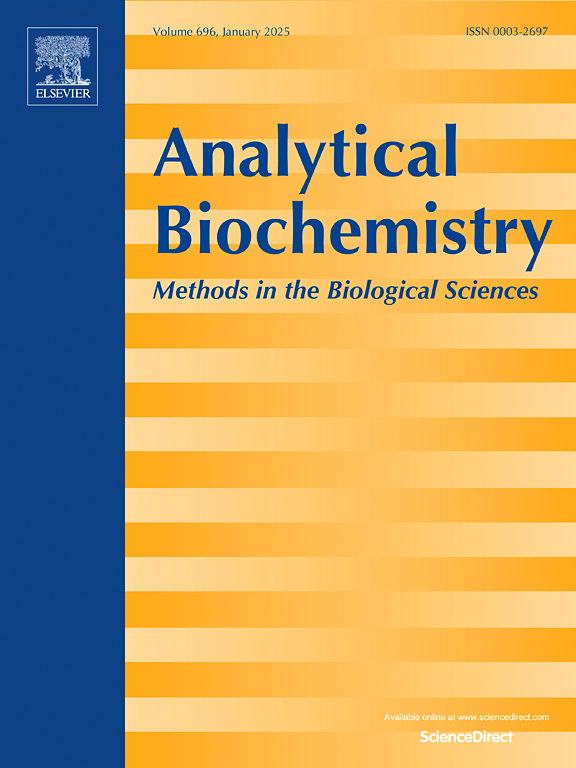介孔碳纳米球辅助放大电化学发光检测l -半胱氨酸。
IF 2.6
4区 生物学
Q2 BIOCHEMICAL RESEARCH METHODS
引用次数: 0
摘要
利用负载鲁米诺的介孔碳纳米球(MCs@LU)开发了一种高灵敏度的电化学发光(ECL)传感器,用于检测l-半胱氨酸(L-Cys)。L-Cys作为鲁米诺的共反应物,介孔碳(MCs)的孔约束效应导致了鲁棒的ECL信号。优化后,ECL强度与L-Cys浓度在5.0 × 10-10 mol·L-1 ~ 5.0 × 10-6 mol·L-1范围内呈线性相关。检测限为1.67 × 10-10 mol·L-1,信噪比为3。此外,ECL传感器对L-Cys具有良好的重现性、稳定性和选择性,并成功应用于药物样品中L-Cys的定量分析。本文章由计算机程序翻译,如有差异,请以英文原文为准。

Mesoporous carbon nanospheres-assisted amplified electrochemiluminescence for l-cysteine detection
Luminol-loaded mesoporous carbon nanospheres (MCs@LU) were utilized to develop a highly sensitive electrochemiluminescence (ECL) sensor for the detection of L-cysteine (L-Cys). L-Cys acted as the coreactant of luminol, and the pore confinement effect of mesoporous carbons (MCs) resulted in a robust ECL signal. Upon optimization, a linear correlation between the ECL intensity and L-Cys concentration was observed over the range of 5.0 × 10−10 mol L−1 to 5.0 × 10−6 mol L−1. The detection limit, with a signal-to-noise ratio of 3, was determined to be 1.67 × 10−10 mol L−1. Additionally, the ECL sensor exhibited good reproducibility, stability, and selectivity for L-Cys and was successfully applied to the quantification of L-Cys in drug samples.
求助全文
通过发布文献求助,成功后即可免费获取论文全文。
去求助
来源期刊

Analytical biochemistry
生物-分析化学
CiteScore
5.70
自引率
0.00%
发文量
283
审稿时长
44 days
期刊介绍:
The journal''s title Analytical Biochemistry: Methods in the Biological Sciences declares its broad scope: methods for the basic biological sciences that include biochemistry, molecular genetics, cell biology, proteomics, immunology, bioinformatics and wherever the frontiers of research take the field.
The emphasis is on methods from the strictly analytical to the more preparative that would include novel approaches to protein purification as well as improvements in cell and organ culture. The actual techniques are equally inclusive ranging from aptamers to zymology.
The journal has been particularly active in:
-Analytical techniques for biological molecules-
Aptamer selection and utilization-
Biosensors-
Chromatography-
Cloning, sequencing and mutagenesis-
Electrochemical methods-
Electrophoresis-
Enzyme characterization methods-
Immunological approaches-
Mass spectrometry of proteins and nucleic acids-
Metabolomics-
Nano level techniques-
Optical spectroscopy in all its forms.
The journal is reluctant to include most drug and strictly clinical studies as there are more suitable publication platforms for these types of papers.
 求助内容:
求助内容: 应助结果提醒方式:
应助结果提醒方式:


